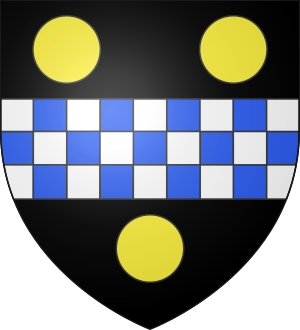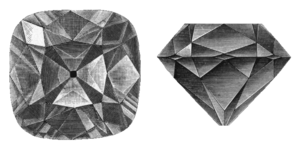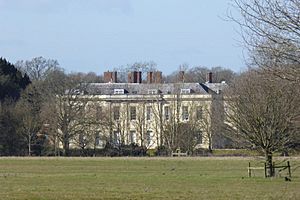Thomas Pitt facts for kids
Quick facts for kids
Thomas Pitt
|
|
|---|---|
 |
|
| President of Fort St George (Madras) | |
| In office 7 July 1698 – 18 September 1709 |
|
| Preceded by | Nathaniel Higginson |
| Succeeded by | Gulston Addison |
| Personal details | |
| Born | 5 July 1653 Blandford Forum, Dorset, England |
| Died | 28 April 1726 (aged 72) |
| Signature |  |
Thomas Pitt (born July 5, 1653 – died April 28, 1726) was an important English merchant. He was known as Governor Pitt or "Diamond" Pitt. He traded a lot with India. He also served as the leader of the East India Company in Madras (now Chennai, India). Pitt was elected to the English Parliament six times. He was the grandfather of William Pitt, 1st Earl of Chatham, and the great-grandfather of Pitt the Younger. Both of these descendants later became Prime Ministers of Great Britain.
Contents
Who Was Thomas Pitt?
Thomas Pitt was born in Blandford Forum, England. He was the second son of Rev. John Pitt. His family had been important in the area for a long time. One of his ancestors, John Pitt, was a merchant and worked for the government. This family also included Sir William Pitt, who was a Member of Parliament.
Adventures in India
In 1674, Thomas Pitt traveled to India. He worked with the East India Company. This company had a special right to trade in India. However, Pitt also started trading on his own. This was against the company's rules. People who did this were called "interlopers."
When he returned to England, he had to pay a fine for his independent trading. But he was already very rich! He used some of his money to buy land in a place called Stratford-sub-Castle, Wiltshire. This land included a special area called Old Sarum.
Old Sarum was a "rotten borough." This meant it had very few people living there, but it could still elect a Member of Parliament. By owning this land, Pitt gained a seat in the House of Commons. This was a big deal because his family would keep this seat for many years. His famous descendants would later use this seat too.
Pitt went back to India and eventually worked for the East India Company again.
Leading the East India Company
In 1698, Thomas Pitt became the President of the East India Company in Madras. This was a very important job. He was in charge of the company's business and forts there.
One of his first tasks was to help end a conflict called Child's War. This was a dispute with the Mughal Emperor Aurangzeb. In 1699, he was made the Governor of Fort St. George. This was the main British fort in Madras.
In 1702, the fort was attacked by a local Mughal leader named Daud Khan of the Carnatic. Pitt was told to try and make peace. He also bought more land for the company in the Carnatic region.
To protect Madras, Pitt started hiring local soldiers called sepoys. These soldiers were from Hindu warrior groups. He gave them modern weapons and had English officers lead them. This helped keep Madras safe from further attacks.
Governor of Madras
Pitt was the President of Madras from July 7, 1698, to 1709. During his time, he made many changes.
In 1699, another English company tried to take over. But the English government made it clear that only King William III could appoint leaders.
In 1700, the government of Fort St George banned cock-fighting and other traditional games. They thought these games made people poor.
Pitt's time as governor is often called the 'Golden Age of Madras'. He made the walls of Black Town stronger. He also made a detailed map of the city. Pitt is most famous for buying five new towns for Madras. These towns were Tiruvatiyoor, Kathiwakam, Nungambakkam, Vyasarpady, and Sathangadu.
Later Life and Politics
After his time in India, Pitt needed more money. He had given a lot of gifts to his family. In 1716, he gave up his seat in Parliament. He planned to become the governor of Jamaica.
However, his money problems were solved when he sold a very large diamond. Because of this, he resigned from the Jamaica job without even going there. He was soon elected back to Parliament. He represented Thirsk and then Old Sarum again. He finally left Parliament in 1726.
Family Life
On January 1, 1679, Thomas Pitt married Jane Innes. She was the niece of Matthias Vincent, one of Pitt's business partners. They had at least four sons and two daughters:
- Robert Pitt (1680-1727): He was Thomas's oldest son. Robert was the father of William Pitt, 1st Earl of Chatham. This William Pitt was known as "Pitt the Elder" and became a Prime Minister. "Pitt the Elder" was also the father of William Pitt the Younger, who also became a Prime Minister.
- Thomas Pitt, 1st Earl of Londonderry (around 1688-1729): He was Thomas's second son.
- William Pitt: He was Thomas's third son and twin to Thomas. He likely died when he was very young.
- Col. John Pitt (1698–1754): He was a respected soldier.
- Essex Pitt: She was the oldest daughter.
- Lucy Pitt: She was the second daughter. She married James Stanhope, 1st Earl Stanhope, who was a soldier and a chief minister for King George I.
The Famous Pitt Diamond
Thomas Pitt is most famous for buying a huge diamond. It weighed 410 carats (about 82 grams) when it was rough. He bought it from an Indian merchant in Madras in 1701. This diamond is now known as the Regent Diamond.
There's a story about how the diamond was found. It was supposedly found by an enslaved man in a mine near the Krishna River. The man hid the diamond in a wound on his leg. He then escaped and met an English sea captain. The man offered the captain half of the money from selling the diamond if the captain would help him leave India. But the story says the captain killed the man and sold the diamond to the merchant.
Pitt bought the diamond for a lot of money, about £20,400. He sent it back to England in 1702. He hid it inside his oldest son Robert's shoe!
From 1704 to 1706, a jeweler in London worked on the diamond. He cut it into a beautiful 141-carat gem. Smaller pieces from the cutting were sold to Peter the Great of Russia.
Pitt tried to sell the main diamond to many European kings and queens. In 1717, he finally sold it to the French regent, Philippe II, Duke of Orléans, for £135,000. It became one of the crown jewels of France. Today, this diamond, called "Le Régent," is on display at the Louvre museum in Paris.
Pitt owned some land where the lord of the land could claim his most valuable possession after his death. If he hadn't sold the diamond, it might have been taken as a special tax after he died.
Because of this amazing diamond, Thomas Pitt earned the nickname "Diamond" Pitt.
Properties and Homes
In 1686, Thomas Pitt leased a place called Mawarden Court near Salisbury. He also bought land in the Old Sarum area. His family continued to lease this land until 1805. He paid to rebuild the tower of St Lawrence's church in 1711. He also provided furniture and plates for the church.
With the money he got from selling the famous diamond in 1717, he bought even more properties. Besides Mawarden Court, he bought Boconnoc in Cornwall. He also acquired Kynaston in Dorset, and other places in Cornwall. He bought Abbot's Ann in Hampshire, where he rebuilt the church. His favorite home was Swallowfield Park in Berkshire, where he passed away in 1726.




